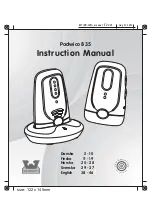
If a remote work voltage sense lead is used, it
must be enabled through the Fanuc Teach
Pendant or with the Weld Manager Utility (includ-
ed on the Power Wave Utilities and Service
Navigator CD
ʼ
s or available at www.power-
wavesoftware.com).
-----------------------------------------------------------------------
Voltage Sensing Considerations for Multiple Arc
Systems
Special care must be taken when more than one arc
is welding simultaneously on a single part. Multiple
arc applications do not necessarily dictate the use of
remote work voltage sense leads, but they are strong-
ly recommended.
If Sense Leads ARE NOT Used:
• Avoid common current paths. Current from adja-
cent arcs can induce voltage into each others cur-
rent paths that can be misinterpreted by the power
sources, and result in arc interference.
If Sense Leads ARE Used:
•
Position the sense leads out of the path of the
weld current.
Especially any current paths com-
mon to adjacent arcs. Current from adjacent arcs
can induce voltage into each others current paths
that can be misinterpreted by the power sources,
and result in arc interference.
•
For longitudinal applications
, connect all work
leads at one end of the weldment, and all of the
work voltage sense leads at the opposite end of the
weldment. Perform welding in the direction away
from the work leads and toward the sense leads.
(See Figure A.3
)
A-15
INSTALLATION
POWER WAVE
®
i400
A-15
Work Voltage Sensing
The POWER WAVE
®
i400 is configured at the factory
to sense work voltage at the negative output stud
(positive output polarity with remote Work Voltage
Sensing disabled).
Negative electrode polarity operation WITHOUT
use of a remote work sense lead (21) requires the
Negative Electrode Polarity attribute to be set via
the Fanuc Teach Pendant or with the Weld
Manager Utility (included on the Power Wave
®
Utilities and Service Navigator CD
ʼ
s or available at
www.powerwavesoftware.com).
-----------------------------------------------------------------------
While most applications perform adequately by sens-
ing the work voltage directly at the output stud, the
use of a remote work voltage sense lead is recom-
mended for optimal performance. The remote WORK
sense lead (21) can be accessed through the four-pin
voltage sense connector located on the control panel
by using the K940 Sense Lead Kit. It must be
attached to the work as close to the weld as practical,
but out of the weld current path. For more information
regarding the placement of remote work voltage sense
leads, see the section entitled "Voltage Sensing
Considerations for Multiple Arc Systems."
WARNING
CAUTION
DIRECTION
OF TRAVEL
CONNECT ALL
WORK LEADS AT
THE BEGINNING
OF THE WELD.
CONNECT ALL SENSE
LEADS AT THE END
OF THE WELD.
FIGURE A.3
















































